As of January 21, 2018: 
Monthly Archives: April 2017
Hotchner: Dealing With Self-Sticks
Dealing With Self-Sticks
By John M. Hotchner
 Hardly any stamp collector is happy with the Postal Service’s practice, begun in earnest in 2007, of producing increasing numbers of self-stick issues that when used, can’t be floated free of the envelope paper.
Hardly any stamp collector is happy with the Postal Service’s practice, begun in earnest in 2007, of producing increasing numbers of self-stick issues that when used, can’t be floated free of the envelope paper.
The reason given was that they were saving on the cost of the stamp paper. But this developed later. Initially there was no announcement. Collectors made the discovery through trying to wash new issues so as to have a nice clean example to put in the album.
Actually about a quarter of what is issued these days can be soaked off — even today. But the remainder either have to be specially treated, stamp by stamp, to be removed. Or, they have to be left on neatly clipped (hope- fully thin) paper and put in the album.
The latter will not bother some people, but as most of us are creatures of habit, the change from the old way is annoying. It makes the presentation of a used collection on album pages a bit disorderly with different thicknesses and colors of envelope paper. Even mint self-stick stamps have to be left on their backing paper when displayed in albums. Thus, fewer stamps will t on a page, and albums get thicker faster. Not a few collectors have reacted to this new era by combining this problem with ever higher face values of stamps, and using these excuses to stop collecting U.S. stamps issued after 2000, or to leave the hobby altogether.
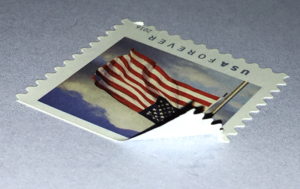 But are the changes really fatal, or do they simply force changes in collecting with which we are unhappy? Are we over-reacting to what we see as high handedness on the part of the USPS? Personally, I feel it, and there can be little doubt that there is some of this in the reaction of collectors. As confirmation, we saw it in letters to the editor in the philatelic press as the USPS went to unwashable self-sticks, and then decreed that all issues would be self-sticks.
But are the changes really fatal, or do they simply force changes in collecting with which we are unhappy? Are we over-reacting to what we see as high handedness on the part of the USPS? Personally, I feel it, and there can be little doubt that there is some of this in the reaction of collectors. As confirmation, we saw it in letters to the editor in the philatelic press as the USPS went to unwashable self-sticks, and then decreed that all issues would be self-sticks.
The latter decision was popular with the public, but it was anything but for collectors. It is still my belief that this could be “fixed” by leaving mail-use stamps self-stick, and issuing commemoratives as lick-and-stick since their purpose is to be sold to collectors. And I would like to see the Postal Service return to the days of washable self-sticks. This would seem to be only rational given that reporting in the philatelic press indicated that the stamps issued without that feature actually cost more than washable stamps.
But I’m dreaming. Back to reality.
The basic question is this: Will you let the changes wrought by the USPS drive you out of the hobby? Or will you find a way to adapt? I can’t picture life without stamp collecting! So adapting is the way I have gone, and the way I recommend.
For those who think that they will teach the Postal Service a thing or two by dropping out with a blast in the Letters to the Editor column, forget it. They have set their course, and are “driving hard to the basket”, to mix a metaphor.
The only power you have is the power of the purse. If you do not spend money on their products, that has an impact. But the USPS is busily about the task of recruiting new collectors who take as a given the new reality. Apparently, they are having success sufficient to offset losses of old-line collectors who are dropping out.
So, the first way to adapt, is not dropping out alto- gether but limiting U.S. stamp collecting to those issues that are pleasing; say ending with the issues of 2000 or 2005. You save on supplements as well as stamps. And this allows you to spend available money on lling in older spaces with those beautifully engraved stamps of yesteryear.
But if, like me, you maintain your interest in the cur- rent issues of the USPS, then there are several avenues you can take:
1. In choosing stamps-on-paper for your album, consider the color and thickness of stamps to be part of condition. Thin white paper is the goal, and just as you would replace a heavily cancelled stamp with one that is lightly cancelled, replace thick red paper when you can.
2. Choose the margin size you will use for consistency, and trim the excess paper so that your album page looks nice.
3. Obtain and learn to use the Scott U.S. Specialized Catalogue, which has a feature identifying those modern stamps that can and cannot be washed. Then wash what you can. I am hopeful that Scott will eventually add this feature to the U.S. listings in Volume I of the Standard Catalogue. (Note: Keep in mind that I have found several stamps that Scott indicates can be washed are at best very difficult, and at worst, actually won’t wash. Best to try one or two before trying to wash quantities.)
[Note: For three years, The Virtual Stamp Club kept track of which U.S. self-adhesives 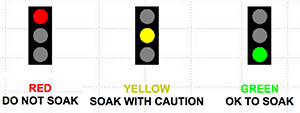 were soakable, through the hard work of volunteer John Cropper. Then he had to move on, and no one else was able to undertake this task. But the “Soaking Stoplight” information is still online here for 2008, 2009 and 2010. — VSC]
were soakable, through the hard work of volunteer John Cropper. Then he had to move on, and no one else was able to undertake this task. But the “Soaking Stoplight” information is still online here for 2008, 2009 and 2010. — VSC]
4. Consider removing the envelope paper from stamps destined for your album using one of the spray or chemical products that have been discussed in Linn’s [Stamp News] and The American Philatelist (mostly in letters to the editor). Although it takes more time than the old float-free method, and for that reason is not suitable for large quantities, it works well on individual stamps. I use non-aerosol “Pure Citrus” Orange Air Freshener which is available at Home Depot and other locations. It is effective and non-toxic.
I will close with an offer. I will provide a write-up on how I use “Pure Citrus”, and/or a write-up of how to separate some of the more difficult soakable stamps from paper to any reader who requests one or both. If you want these, please write to me, specifying which, and enclose 10¢ in mint postage to cover photocopying, and a stamped addressed envelope. Send to me at PO Box 1125, Falls Church, VA 22041-0125.
Should you wish to comment on this column, or have questions or ideas you would like to have explored in a future column, please write to John Hotchner, VSC Contributor, P.O. Box 1125, Falls Church, VA 22041-0125, or email, putting “VSC” in the subject line.
Or comment right here.
King Willem-Alexander’s 50th Birthday (Netherlands 2017)
[press release]
Stamps depicting the life of fifty-year-old King Willem-Alexander
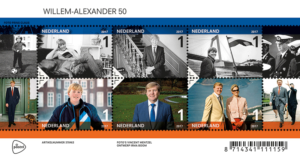 The Hague, 24 April 2017 – PostNL is issuing a special stamp sheetlet honouring King Willem-Alexander’s fiftieth birthday. The ten pictures show the various periods in the life of the king. The images are featured on six stamps and on four tabs to the left and right of the stamps.
The Hague, 24 April 2017 – PostNL is issuing a special stamp sheetlet honouring King Willem-Alexander’s fiftieth birthday. The ten pictures show the various periods in the life of the king. The images are featured on six stamps and on four tabs to the left and right of the stamps.
Nine of the photos on the stamp sheetlet were taken by photo journalist Vincent Mentzel. The tenth photo was taken by Prince Claus of a young Willem-Alexander with a football in the garden of Drakensteyn Castle. Mentzel sees this photo as an homage to his father. Together with designer Irma Boom, he opted to use black and white photos for the informal moments of the king’s life. The colour images show the more formal moments of King Willem-Alexander.
Journalistic photos of a Head of State
For this stamp sheetlet, Mentzel and Boom made a selection of historic photos from the photography book Koninklijke Foto’s [Royal Photos] – Vincent Mentzel. “The photos in this book show Willem-Alexander’s personality and his tastes. It’s perhaps most clearly shown in the photo taken in Rotterdam. It has it all: the smile, the flag, the water, the boat, the Willemsbrug. The other photos feature more active aspects, like the one of him walking down the street on a state visit to China, or of his time in the navy. They’re not glamour photos; they’re photo journalism. You see a boy who will go on to become Head of State. And you see the man he is now,” Mentzel says.
Availability
Each ‘Willem-Alexander 50’ stamp sheetlet consists of six stamps marked with ‘Nederland 1’, which can be used for items weighing up to 20g destined for mail in the Netherlands. These stamps will be available from 24 April at all Bruna shops and via Collectclub.nl. The stamps are valid until further notice. 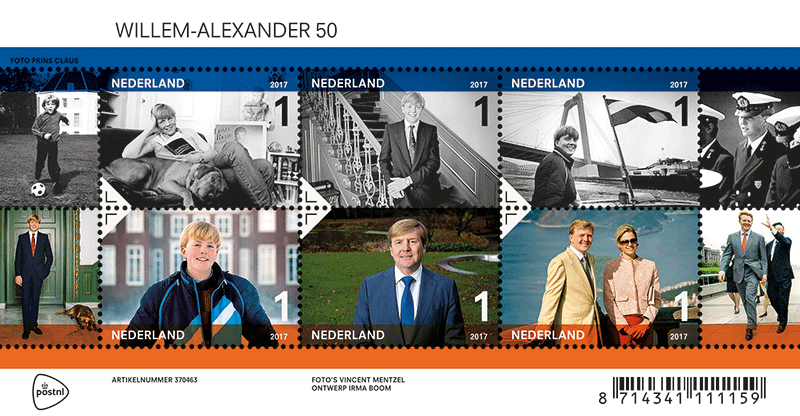
Botanical Gardens (Netherlands 2017)
[press release]
Botanical gardens bloom on new stamp sheetlet
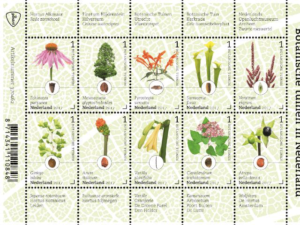 The Hague, 25 April 2017 – PostNL is issuing a new stamp sheetlet to mark the occasion of the Year of the Botanical Gardens in 2017. The stamps feature ten special plants and trees. These crown jewels are all from botanical gardens in the Netherlands.
The Hague, 25 April 2017 – PostNL is issuing a new stamp sheetlet to mark the occasion of the Year of the Botanical Gardens in 2017. The stamps feature ten special plants and trees. These crown jewels are all from botanical gardens in the Netherlands.
The Netherlands has more than thirty botanical gardens, twenty-four of which are members of The Dutch Foundation of Botanical Gardens (NVBT). The Foundation has dedicated 2017 to highlighting the most unique, unusual and threatened species of plants and trees. The gardens are home to 47,000 types of plants and trees from all over the world.
Individual character visible on stamp
From a selection of around one hundred possible plants and trees, designer Robbert Zweegman choose ten ‘crown jewels’ for the new stamp sheetlet. He had nature photographer Edwin Giesbers photograph all of them individually. “This makes visible the individual character of the plant or tree, as a symbol for the botanical garden. You also avoid the distraction of the environment; you have no context and no other plants nearby,” says Zweegman, explaining the choice of the images.
Renowned botanical gardens on stamp sheetlet
The stamps feature well-known plants and trees. These include the deadly nightshade (Hortus Botanicus Amsterdam), black false hellebore (Holland Open Air Museum Arnhem), the yellow pitcher plant (Kerkrade Botanical Garden), the purple coneflower (Hortus Alkmaar) and the orange trumpet vine (Utrecht Botanical Gardens). Zweegman also chose to include the Latin name of each plant or tree in the design. In doing so, he is referring to the Swedish plant expert Carl Linnaeus, who classified plants and trees into logical categories in the 18th century and assigned them a two-part Latin name.
Availability
The ‘Botanical Gardens in the Netherlands’ stamp sheetlet consists of ten stamps marked with ‘Nederland 1’, which can be used for items weighing up to 20g destined for mail in the Netherlands. These stamps will be available from 24 April at all Bruna shops and via Collectclub.nl. The stamps are valid until further notice. 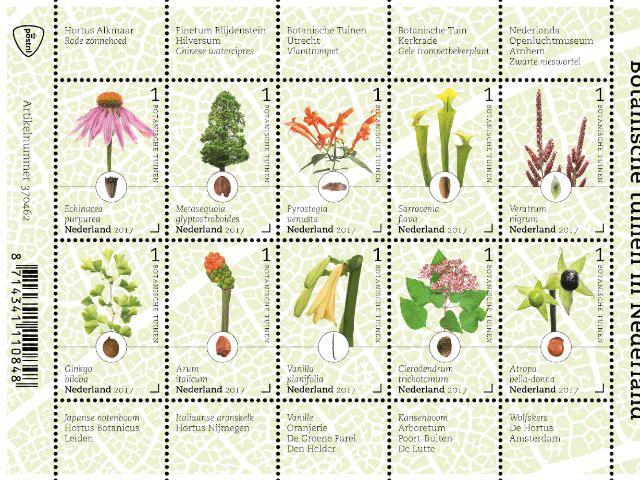
British Songbirds (UK 2017)
[from Royal Mail]
Issue Date: 4th May 2017
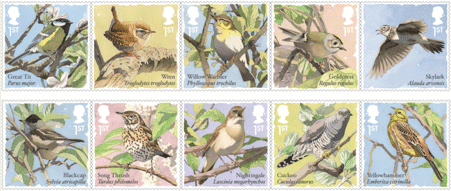
This 10-stamp issue explores some familiar and less well-known songbirds, whose song defines the British spring and early summer, from birds with simple songs to those with complex repertoires.
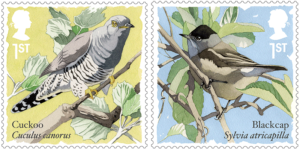 MINT STAMPS IN DETAIL
MINT STAMPS IN DETAIL
Price: £6.50
Code: AS2596
Printed in se-tenent strips of five: All First Class.
Technical Details:
Number of stamps: 10
Value of Stamps: 10 x First Class
Design: Stamp Design: Osborne Ross
Illustrations: Federico Gemma
Stamp Size: 35mm x 35mm
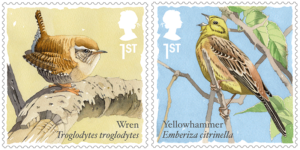 Stamp Format: Square
Stamp Format: Square
Printer: International Security Printers
Print Process: Lithography
Perforations: 14.5 x 14.5
Phosphor: Bars as appropriate
Gum: PVA 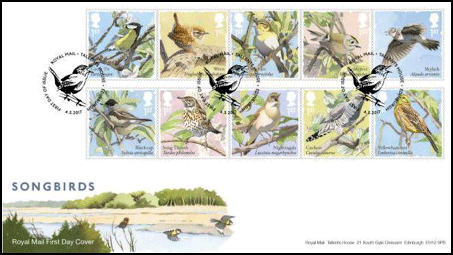 The First Day Covers (above) Feature All 10 Mint Stamps and a special First Day of Issue postmark.
The First Day Covers (above) Feature All 10 Mint Stamps and a special First Day of Issue postmark. 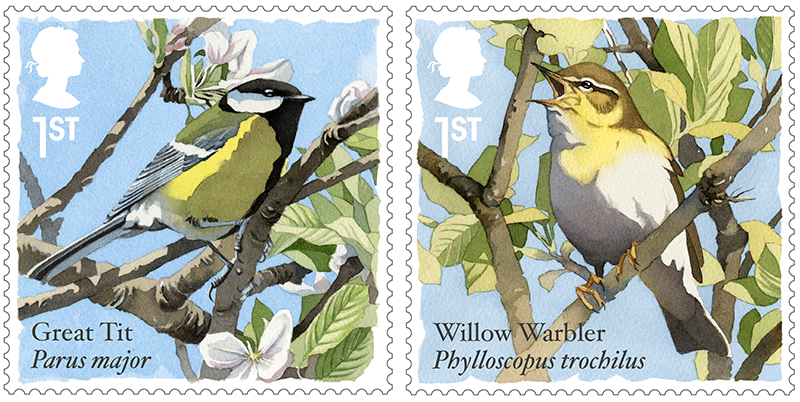
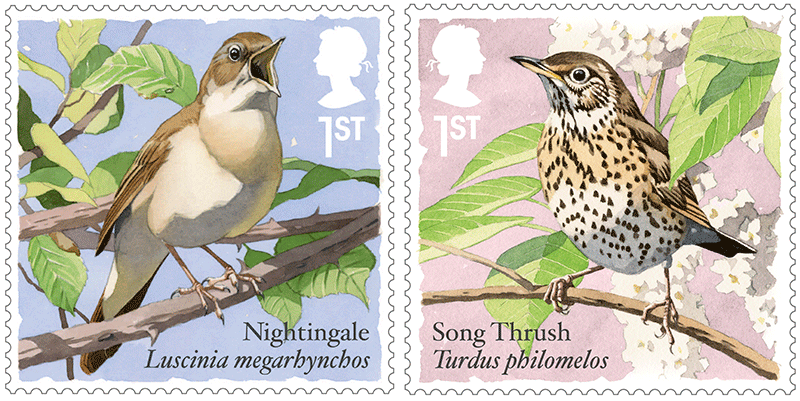

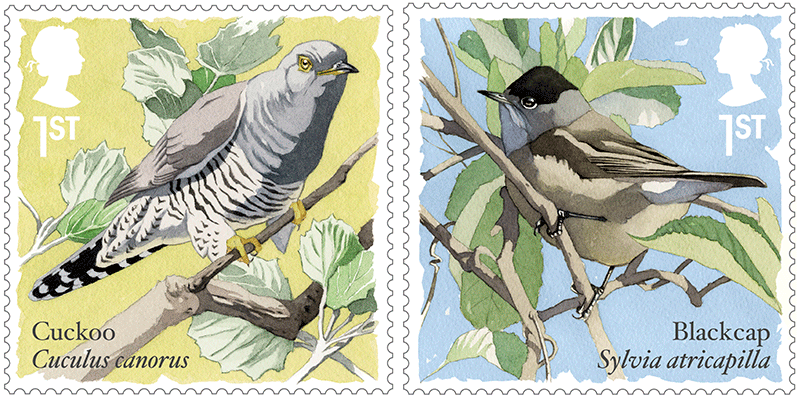
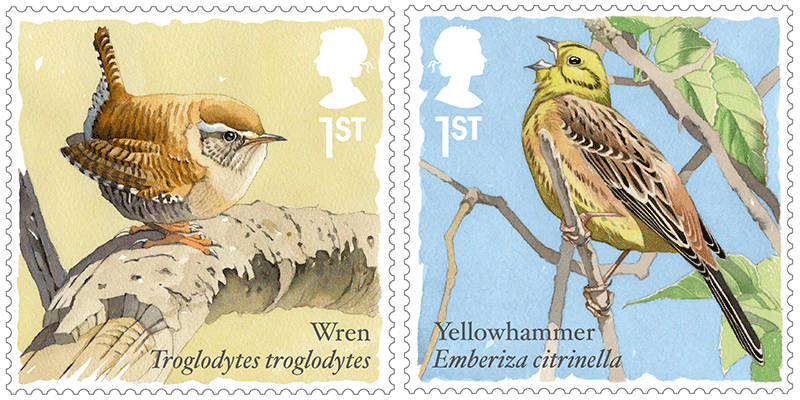
Star Trek 2017 (Canada 2017)
[press release]
Admiral James T. Kirk and Starfleet’s finest captains materialize on dramatic Canadian Star Trek™ stamps
Bold explorers are shadowed by the menacing villains they faced
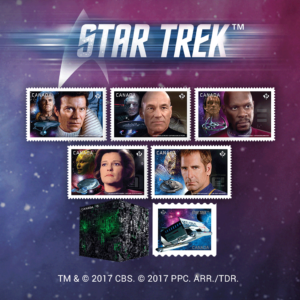 OTTAWA, April 28, 2017 /CNW/ – Canada Post today issued a set of seven Star Trek stamps that celebrate each of Starfleet’s finest leaders, dramatically depicting them with the most cunning of the adversaries they confronted on their voyages.
OTTAWA, April 28, 2017 /CNW/ – Canada Post today issued a set of seven Star Trek stamps that celebrate each of Starfleet’s finest leaders, dramatically depicting them with the most cunning of the adversaries they confronted on their voyages.
Five stamps are dedicated to the exploits of James T. Kirk (Montréal-born actor William Shatner), Jean-Luc Picard (Patrick Stewart), Benjamin Sisko (Avery Brooks), Kathryn Janeway (Kate Mulgrew) and Jonathan Archer (Scott Bakula).
Two additional stamps feature the intrepid shuttlecraft Galileo, which was often deployed for missions too dangerous for the U.S.S. Enterprise, and the ominous Borg cube, which has been specially enhanced with holographic foil and embossing.
A sequel to last year’s 50th anniversary collection, these seven stamps feature:
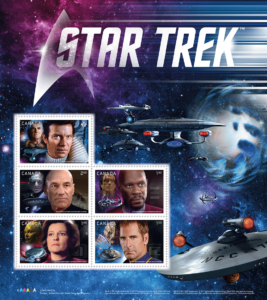 Admiral James T. Kirk with Khan Noonien Singh (Star Trek II: The Wrath of Khan™, 1982)
Admiral James T. Kirk with Khan Noonien Singh (Star Trek II: The Wrath of Khan™, 1982)- Captain Jean-Luc Picard with Locutus of Borg (Star Trek: The Next Generation™, 1987-1994)
- Captain Benjamin Sisko with Dukat (Star Trek: Deep Space Nine™, 1993-1999)
- Captain Kathryn Janeway with the Borg Queen (Star Trek: Voyager™, 1995-2001)
- Captain Jonathan Archer with Commander Dolim (Star Trek: Enterprise™, 2001-2005)
- The classic shuttlecraft Galileo (first appearance in Star Trek, 1966)
- The Borg cube (first appearance in Star Trek: The Next Generation, 1989)
About the stamps
Designed by Signals Design Group and printed by the Lowe-Martin Group, the five stamps featuring Starfleet heroes measure 24 mm by 30 mm and are available in booklets of 10, as a pane of five stamps, and as an uncut press sheet. The 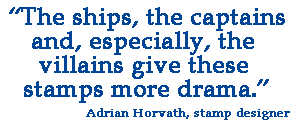 shuttlecraft stamp, measuring 24 mm by 20 mm, is available as a coil of 50 stamps. All seven stamps, including the uniquely-shaped Borg cube, which measures 67 mm by 62 mm and is enhanced with holographic foil and embossing, are available ready-to-mail in a prestige booklet. The Official First Day Covers – all cancelled in Vulcan, Alberta, except Kirk’s, which is cancelled in Montréal, Quebec – are available only as a set of seven.
shuttlecraft stamp, measuring 24 mm by 20 mm, is available as a coil of 50 stamps. All seven stamps, including the uniquely-shaped Borg cube, which measures 67 mm by 62 mm and is enhanced with holographic foil and embossing, are available ready-to-mail in a prestige booklet. The Official First Day Covers – all cancelled in Vulcan, Alberta, except Kirk’s, which is cancelled in Montréal, Quebec – are available only as a set of seven.
From Canada Post’s Details magazine (philatelic catalogue):
Captain’s log
Stardate: April 27, 2017. A second year on the edge of the final frontier concludes our exploration of the best of Star TrekTM. We’ve discovered seven new stamps and added them to our collection. Led by James T. Kirk (played by Montréal-born William Shatner), they feature three Starfleet captains who followed in his footsteps and one who made humanity’s first foray into interstellar space. Although we have made some great discoveries, our mission has also been dangerous. Starfleet’s finest share their stamps with some of the galaxy’s most nefarious villains. We also learned of a tiny but intrepid shuttlecraft coil stamp and a large, looming Borg design …
TRANSMISSION INTERRUPTED …
INCOMING TRANSMISSION …
We are the Borg. Lower your shields and prepare to be assimilated. Your technological and philatelic distinctiveness will be added to our own. Your stamps will bring us closer to perfection. Resistance is futile.
After Star Trek finished its three-year run in 1969, fans were left yearning for more stories from the stars. William Shatner’s James T. Kirk had captured imaginations and, with fan interest mounting, Star Trek: The Motion Picture debuted in 1979, kicking off six original series feature films – including fan favourite Star Trek II: The Wrath of Khan. But Kirk did more than inspire fans, he set the standard for every Starfleet captain to come. Five stamps in this issue pay homage to Kirk and his counterparts Jean-Luc Picard, Benjamin Sisko, Kathryn Janeway and Jonathan Archer. These Starfleet heroes saved the galaxy time after time, even in the face of the seemingly unstoppable villains whose likenesses loom in the background. Two other stamps celebrate the intrepid Class-F shuttle and ominous Borg cube.
Designed by Kosta Tsetsekas and Adrian Horvath, of Signals Design Group, these stamps share a similar look to those issued in 2016, with a more modern feel.
“There’s more drama,” says Horvath, adding that, as a fan of Star Trek: The Next Generation, revisiting the futuristic series stoked a renewed interest in his favourite episodes.
Admiral Kirk vs. Khan Noonien Singh
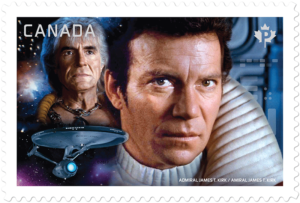 After completing his original five-year mission and earning a promotion, Admiral James T. Kirk set an unassailable standard for every Starfleet captain. But being stuck behind a desk at Starfleet Command made the aging admiral restless. Kirk rejoined the U.S.S. Enterprise, the first step toward a final show- down with his most cunning and deadly adversary: Khan. Set on revenge, the genetically enhanced superhuman cost Kirk the life of his closest companion.
After completing his original five-year mission and earning a promotion, Admiral James T. Kirk set an unassailable standard for every Starfleet captain. But being stuck behind a desk at Starfleet Command made the aging admiral restless. Kirk rejoined the U.S.S. Enterprise, the first step toward a final show- down with his most cunning and deadly adversary: Khan. Set on revenge, the genetically enhanced superhuman cost Kirk the life of his closest companion.
Captain Picard vs. Locutus of Borg
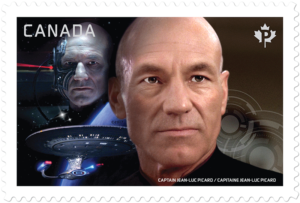 More “by the book” than Kirk, Captain Jean-Luc Picard led his crew with stern professionalism. When Borg drones invaded the U.S.S. Enterprise-D, they captured and assimilated Picard into the Borg Collective. Renamed Locutus and forced to be the Borg’s spokesperson, Picard was eventually rescued by his crew, though not before he was the Borg’s unwilling agent of destruction. Haunted, Picard finally overcame his demons in a final showdown with the Borg Queen.
More “by the book” than Kirk, Captain Jean-Luc Picard led his crew with stern professionalism. When Borg drones invaded the U.S.S. Enterprise-D, they captured and assimilated Picard into the Borg Collective. Renamed Locutus and forced to be the Borg’s spokesperson, Picard was eventually rescued by his crew, though not before he was the Borg’s unwilling agent of destruction. Haunted, Picard finally overcame his demons in a final showdown with the Borg Queen.
Captain Sisko vs. Dukat
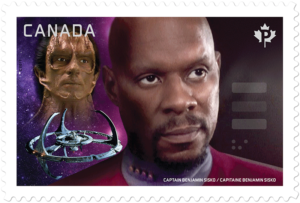 Posted to the space station Deep Space 9, near the planet Bajor, Captain Benjamin Sisko took to heart his mission to help the Bajorans recover from the Cardassian occupation. Dukat, the dangerous former prefect of the station, considered Sisko’s new role as a personal affront – and wanted revenge. This animosity led to escalating tensions between the Federation and a new, powerful enemy known as the Dominion, and placed Captain Sisko at the centre of a battle between good and evil.
Posted to the space station Deep Space 9, near the planet Bajor, Captain Benjamin Sisko took to heart his mission to help the Bajorans recover from the Cardassian occupation. Dukat, the dangerous former prefect of the station, considered Sisko’s new role as a personal affront – and wanted revenge. This animosity led to escalating tensions between the Federation and a new, powerful enemy known as the Dominion, and placed Captain Sisko at the centre of a battle between good and evil.
Captain Janeway vs. the Borg Queen
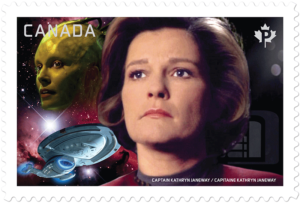 Sent to pursue renegades known as the Maquis, Captain Kathryn Janeway and the crew of the U.S.S. Voyager thought they’d be home in no time. Unexpectedly, Voyager and a Maquis vessel were transported to the other side of the galaxy. Far from home, the two crews united and began a decades- long journey back to the Federation. In the end, Janeway faced off against the enigmatic Borg Queen and used the Collective’s advanced technology to speed Voyager’s return home.
Sent to pursue renegades known as the Maquis, Captain Kathryn Janeway and the crew of the U.S.S. Voyager thought they’d be home in no time. Unexpectedly, Voyager and a Maquis vessel were transported to the other side of the galaxy. Far from home, the two crews united and began a decades- long journey back to the Federation. In the end, Janeway faced off against the enigmatic Borg Queen and used the Collective’s advanced technology to speed Voyager’s return home.
Captain Archer vs. Commander Dolim
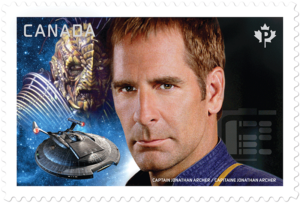 One of Starfleet’s earliest pioneers, Captain Jonathan Archer represented United Earth before the founding of the Federation. In 2153, Archer and the Enterprise NX-01 responded when the mysterious Xindi suddenly attacked Earth. The Enterprise trailed the Xindi to a dangerous region of space known as the Delphic Expanse, where Archer confronted Commander Dolim, a genocidal Xindi-Reptilian convinced that the destruction of humanity would ensure the survival of his people.
One of Starfleet’s earliest pioneers, Captain Jonathan Archer represented United Earth before the founding of the Federation. In 2153, Archer and the Enterprise NX-01 responded when the mysterious Xindi suddenly attacked Earth. The Enterprise trailed the Xindi to a dangerous region of space known as the Delphic Expanse, where Archer confronted Commander Dolim, a genocidal Xindi-Reptilian convinced that the destruction of humanity would ensure the survival of his people.
The shuttlecraft – Galileo
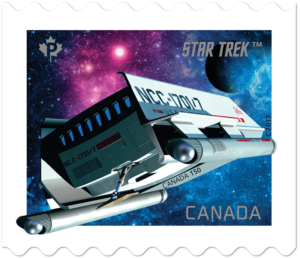 The U.S.S. Enterprise carried a fleet of shuttlecraft designed for short-range space exploration, planetary landings, and (often) dangerous missions. The first of these shuttles – named Galileo (NCC-1701⁄7) – met an explosive fate in orbit around Taurus II, seconds after its crew was beamed safely to the Enterprise. In honour of the spunky little craft, its name was passed on to future models, making it the most famous of the Enterprise sidekicks.
The U.S.S. Enterprise carried a fleet of shuttlecraft designed for short-range space exploration, planetary landings, and (often) dangerous missions. The first of these shuttles – named Galileo (NCC-1701⁄7) – met an explosive fate in orbit around Taurus II, seconds after its crew was beamed safely to the Enterprise. In honour of the spunky little craft, its name was passed on to future models, making it the most famous of the Enterprise sidekicks.
The Borg
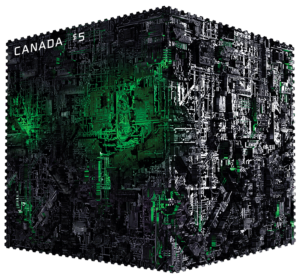 The cybernetic Borg had no interest in diplomacy; they sought only to achieve perfection by assimilating different species. Those assimilated lost all sense of individual identity and became merely an extension of the Borg Collective – a fate many considered worse than death. The appearance of a Borg cube – the Collective’s formidable spaceship – often meant the destruction of a civilization. Resistance, as the Borg said, was futile.
The cybernetic Borg had no interest in diplomacy; they sought only to achieve perfection by assimilating different species. Those assimilated lost all sense of individual identity and became merely an extension of the Borg Collective – a fate many considered worse than death. The appearance of a Borg cube – the Collective’s formidable spaceship – often meant the destruction of a civilization. Resistance, as the Borg said, was futile.
Canada 150: Habitat 67 (Canada 2017)
[press release]
World-renowned architect Moshe Safdie and Canada Post unveil stamp depicting Habitat 67 complex to celebrate Expo 67
Stamp is first in a set of 10 that will capture unforgettable moments of the last 50 years as country celebrates Canada 150
 MONTRÉAL, April 27, 2017 /CNW/ – Canada Post and Moshe Safdie, whose revolutionary Habitat 67 modular housing complex earned global accolades as an icon of urban living, today unveiled a stamp with an image of his futuristic structure representing the event for which it was built: Expo 67.
MONTRÉAL, April 27, 2017 /CNW/ – Canada Post and Moshe Safdie, whose revolutionary Habitat 67 modular housing complex earned global accolades as an icon of urban living, today unveiled a stamp with an image of his futuristic structure representing the event for which it was built: Expo 67.
The Expo 67 stamp is the first of 10 to be issued to mark Canada’s 150th year since Confederation. Each one celebrates a significant and unforgettable moment in the life of this country since its centennial in 1967. The 10 moments and achievements, which have become pillars of Canada’s collective memory, were selected by Canada Post’s stamp advisory committee, which includes historians, collectors and artists. A video featuring Safdie and a magazine article about Expo 67 are available at canadapost.ca/Canada150.
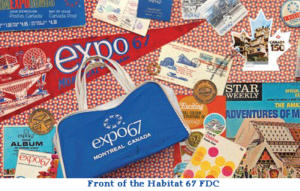 Safdie unveiled the stamp in the very building that forever placed his signature on his adopted city. With Habitat 67, Safdie – a bold, brash and brilliant young architect on the verge of launching a significant global career – captured an era of optimism, energy and progress. This project also launched his incredible career that has had him design prestigious buildings around the world, including the National Gallery of Canada, the Quebec Museum of Civilization, Marina Bay Sands in Singapore and the United States Institute of Peace in Washington, D.C.
Safdie unveiled the stamp in the very building that forever placed his signature on his adopted city. With Habitat 67, Safdie – a bold, brash and brilliant young architect on the verge of launching a significant global career – captured an era of optimism, energy and progress. This project also launched his incredible career that has had him design prestigious buildings around the world, including the National Gallery of Canada, the Quebec Museum of Civilization, Marina Bay Sands in Singapore and the United States Institute of Peace in Washington, D.C.
Habitat 67 was perfect for Expo 67, the international festival that transformed its host city of Montréal and the country itself. Canada introduced itself to the world with Expo 67 as a country of seemingly boundless talent and potential. The event brought Canadians from across the country and visitors from around the world together for six months between April and October 1967. When Canada’s population was only 20 million, more than 50 million people attended. That ratio set a per-capita attendance record for a World’s Fair, which still stands. It is widely considered the most successful World’s Fair of the 20th century.
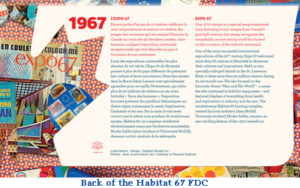 Those six months became a landmark moment for Canada – socially, culturally and politically. Several generations of Canadians have since pointed to it as the signature event of our centennial year. It featured pavilions from 62 countries, as well as Canada’s provinces and territories. It was an opportunity for Canadians to get better acquainted with Quebec culture. It attracted many notable figures of the time, including Queen Elizabeth II, U.S. President Lyndon B. Johnson, Princess Grace of Monaco, Jacqueline Kennedy and Robert F. Kennedy, and Bing Crosby. The Ed Sullivan Show was broadcast live from Expo 67 twice that May. Many Canadians associate Bobby Gimby’s popular centennial tune Ca-na-da with Expo 67.
Those six months became a landmark moment for Canada – socially, culturally and politically. Several generations of Canadians have since pointed to it as the signature event of our centennial year. It featured pavilions from 62 countries, as well as Canada’s provinces and territories. It was an opportunity for Canadians to get better acquainted with Quebec culture. It attracted many notable figures of the time, including Queen Elizabeth II, U.S. President Lyndon B. Johnson, Princess Grace of Monaco, Jacqueline Kennedy and Robert F. Kennedy, and Bing Crosby. The Ed Sullivan Show was broadcast live from Expo 67 twice that May. Many Canadians associate Bobby Gimby’s popular centennial tune Ca-na-da with Expo 67.
With the theme “Man and His World,” the event also showcased Canadian innovation – be it technology, urban planning, industry or architecture. The vision and legacy of Expo 67 still echo today through Montréal’s infrastructure, architecture, public art and the two islands in the St. Lawrence River.
The next stamp in the Canada 150 set will be revealed in Ottawa on Wednesday, May 3. The others will be unveiled individually at cities across the country, the last of them on June 1.
About the stamp
Each of the 10 maple-leaf shaped die-cut PermanentTM domestic-rate stamps measures 40 mm x 40 mm and is printed in 6 colours plus tagging. The self-adhesive stamps are available in a booklet of 10 (4 million stamps). A gummed pane of 10 stamps, with circle perforations 4.5 cm in diameter, is also available (80,000 panes). Official First Day Covers, one for each stamp design and each cancelled in OTTAWA ON, are available in a pack of 10 (10,000 packs). The stamp issue was designed by Roy White and Liz Wurzinger of Subplot Design Inc. in Vancouver, B.C., and printed by the Lowe-Martin Group.
About Moshe Safdie
Moshe Safdie is an architect, urban planner, educator, theorist, and author. Beginning with his architectural thesis at McGill University in 1964 and the pioneering housing complex Habitat 67 in Montréal, Safdie’s design philosophy has been consistently responsive to local historic, cultural, and environmental contexts. With his global firm, Safdie Architects, notable projects include the National Gallery of Canada; Marina Bay Sands in Singapore; Khalsa Heritage Centre in Punjab, India; and the United States Institute of Peace headquarters in Washington, D.C. Safdie has been recognized widely for his enduring influence on the built environment. He is the recipient of the Companion of the Order of Canada, the Gold Medal from both the Royal Architectural Institute of Canada and the American Institute of Architects, la Médaille du Mérite from the Order of Architects of Québec, and the Cooper Hewitt National Design Awards 2016 Lifetime Achievement Award. He continues to inspire the theory and application of ideas about housing, mixed use, and high density in cities around the world.
Celebrities to Unveil Canadian Stamps
[press release]
In honour of Canada 150, notable Canadians will help unveil stamps celebrating 10 unforgettable moments since 1967
Maple leaf-shaped stamps will be a first for Canada Post
OTTAWA – Canada Post has enlisted the help of several distinguished Canadians to unveil 10 special commemorative stamps that celebrate the most significant moments in the life of the country since it proudly marked its Centennial.
In a video message (view here), Canada Post President and CEO Deepak Chopra, joined by Canada Post employees and Steven MacKinnon, Parliamentary Secretary to the Minister of Public Services and Procurement, proudly introduces this special stamp program in celebration of Canada 150, the country’s sesquicentennial.
The impressive Canadians include a country music star, a world-renowned architect, successful business leaders, influential community activists, legendary athletes and an astronaut. Over the next five weeks, separate unveilings will occur, each one at a location chosen to illustrate the story behind the achievement, event or milestone that the stamp commemorates.
This will also be the first time in Canada Post’s history that stamps will be issued in the shape of a maple leaf.
With each stamp unveiling, videos with these notable Canadians, other key participants and archival footage will tell the story of that stamp subject on canadapost.ca/canada150.
The first of the 10 stamps will be unveiled on April 27 in Montréal. The remainder will be revealed separately over five weeks, culminating with the unveiling of two stamps on June 1. On that day, all 10 Permanent™ domestic-rate stamps will be available in various formats – at post offices and online, via mail order or phone. Customers can also pre-order at canadapost.ca/canada150 or by phone.
As with all Canada Post stamps, the subjects were chosen by the Canada Post Stamp Advisory Committee. These 12 members of the public are experts in their particular field. They include historians, archivists, graphic designers, philatelists and others.
[COMMUNIQUÉ]
Pour les 150 ans du Canada, des personnalités canadiennes dévoileront 10 timbres célébrant des moments marquants depuis 1967
Postes Canada émettra pour la toute première fois des timbres en forme de feuille d’érable
OTTAWA – Postes Canada a invité plusieurs Canadiens de renom à participer au dévoilement de 10 timbres commémoratifs soulignant les moments les plus marquants de l’histoire du pays depuis son centenaire.
Dans un message vidéo (visionner ici), le président-directeur général de Postes Canada Deepak Chopra, accompagné d’employés de la Société et de Steven MacKinnon, secrétaire parlementaire de la ministre des Services publics et de l’Approvisionnement, a fièrement présenté le programme de timbres-poste Canada 150 célébrant le cent cinquantenaire du pays.
L’impressionnante liste de personnalités canadiennes invitées compte notamment une vedette de musique country, un architecte de renommée mondiale, des chefs d’entreprise prospères, des activistes communautaires influents, des athlètes légendaires et un astronaute. Au cours des cinq prochaines semaines, les dévoilements individuels auront lieu à des endroits symboliques choisis selon la réalisation ou le moment qu’illustre le timbre présenté.
De plus, pour la toute première fois dans l’histoire de Postes Canada, les timbres émis auront la forme d’une feuille d’érable.
Pour chaque timbre dévoilé, des vidéos mettant en vedette des Canadiens célèbres, d’autres acteurs importants et des images d’archives raconteront l’histoire derrière la vignette sur le site postescanada.ca/150canada.
Le premier des 10 timbres sera dévoilé le 27 avril à Montréal. Les autres seront présentés individuellement sur cinq semaines; les deux derniers seront révélés le 1er juin. Ce jour-là, les 10 timbres PermanentsMC du régime intérieur seront offerts en différents formats. Il sera possible de se les procurer dans les bureaux de poste ou de les commander en ligne, par la poste ou par téléphone. Les clients peuvent également les précommander à l’avance sur le site postescanada.ca/150canada ou par téléphone.
Comme pour tous les timbres de Postes Canada, ces sujets ont été choisis par le Comité consultatif sur les timbres-poste de Postes Canada. Ce comité est composé de 12 membres du public, dont des historiens, des archivistes, des concepteurs, des philatélistes et d’autres experts qui sont tous des sommités dans leur domaine.
Total Eclipse (U.S. 2017)
Updated May 29th:
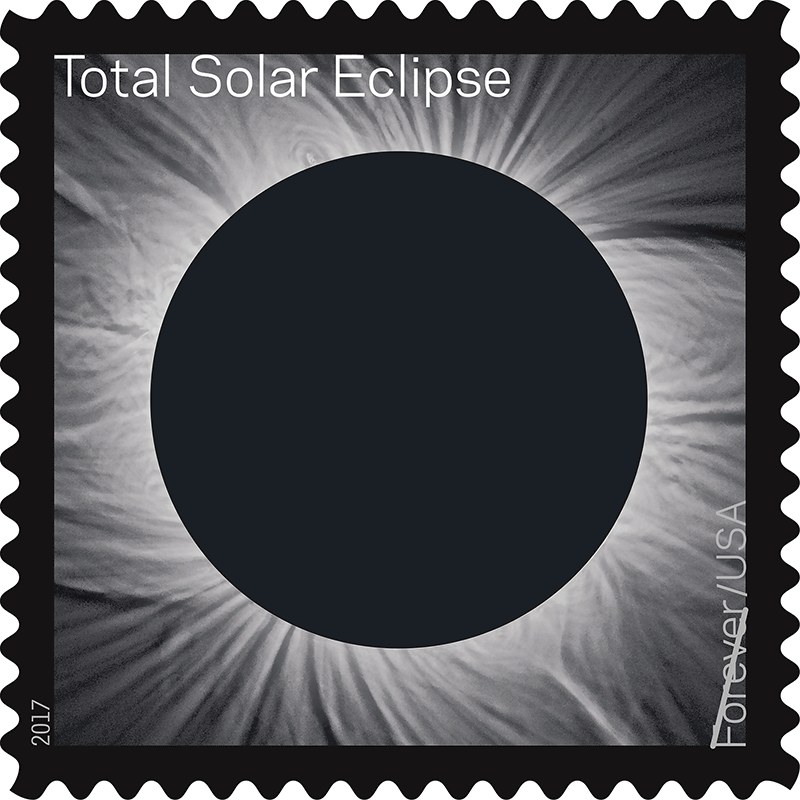
Issue: Total Eclipse of the Sun Stamp
Item Number: 475300
Denomination & Type of Issue: First-Class Mail Forever®
Format: Pane of 16 (1 design)
Series: N/A
Issue Date & City: June 20, 2017, Laramie, WY 82072
Designer: Antonio Alcalá, Alexandria, VA
Art Director: Antonio Alcalá, Alexandria, VA
Typographer: Antonio Alcalá, Alexandria, VA
Existing Photos: Fred Espenak
Modeler: Sandra Lane/Michelle Finn
Manufacturing Process: Offset, Microprint
Printer: Banknote Corporation of America
Printed at: Browns Summit, NC
Press Type: Alprinta 74, ABG Digicon Series 2
Stamps per Pane: 16
Print Quantity: 60 million stamps
Paper Type: Phosphor Tagged Paper, Overall
Adhesive Type: Pressure-sensitive
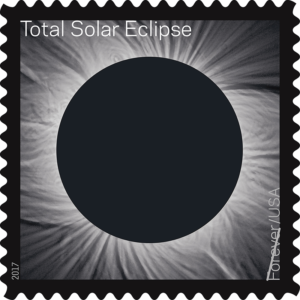 Processed at: Banknote Corporation of America, Browns Summit NC
Processed at: Banknote Corporation of America, Browns Summit NC
Colors: Cyan, Magenta, Yellow, Black, Thermochromic/Black
Stamp Orientation: Vertical
Image Area (w x h): 1.085 x 1.085 in./27.56 x 27.56 mm
Overall Size (w x h): 1.225 x 1.225 in./31.12 x 31.12 mm
Full Pane Size (w x h): 6.00 x 6.00 in./152.40 x 152.40 mm
Press Sheets Size (w x h): 12.00 x 24.50 in./304.8 x 622.30 mm
Plate Size: 128 stamps per revolution
Plate Numbers: “B” followed by five (5) single digits
Marginal Markings:
Front: Plate numbers in two corners of pane
Back: © 2017 USPS • USPS logo • Plate position diagram • Barcode (475300) in upper right and lower left corners of pane • 1 map, “Track of the Total Solar Eclipse Across the United States, August 21, 2017” • Promotional text
Updated May 12th:
 On June 20, 2017, in Laramie, WY, the U.S. Postal Service® will issue the Total Eclipse of the Sun stamp (Forever® priced at 49 cents), in one design, in a pressure-sensitive adhesive (PSA) pane of 16 stamps (Item 475300). The $7.84 Total Eclipse of the Sun pane of 16 stamps may not be split, and the stamps may not be sold individually. The stamps will go on sale nationwide June 20, 2017.
On June 20, 2017, in Laramie, WY, the U.S. Postal Service® will issue the Total Eclipse of the Sun stamp (Forever® priced at 49 cents), in one design, in a pressure-sensitive adhesive (PSA) pane of 16 stamps (Item 475300). The $7.84 Total Eclipse of the Sun pane of 16 stamps may not be split, and the stamps may not be sold individually. The stamps will go on sale nationwide June 20, 2017.
On August 21, 2017, a total solar eclipse will be visible to millions of Americans as it sweeps a narrow path across parts of the entire country. The U.S. Postal Service anticipates this rare event with a stamp celebrating the majesty of total solar eclipses. A total eclipse of the Sun occurs when the Moon completely blocks the visible solar disk from view, casting a shadow on the Earth. The image on the Total Eclipse of the Sun stamp shows a total solar eclipse that was seen over Jalu, Libya, in 2006.
The Total Eclipse of the Sun stamp is the first U.S. stamp to use thermochromic ink, which reacts to the heat of your touch. Placing your finger over the black disc on the stamp causes the ink to change from black to clear to reveal an underlying image of the moon. The image reverts back to the black disc once it cools. The back of the stamp pane shows a map of the eclipse path. Art director Antonio Alcalá designed the stamp with existing photographs taken by astrophysicist Fred Espenak.
Stamp Fulfillment Services will make an automatic push distribution to Post Offices™ of a quantity to cover approximately 30 days of sales.
Special Dedication Postmarks:
 Only the following pictorial postmark is permitted for the Total Eclipse of the Sun stamp. The word “Station” or the abbreviation “STA” is required somewhere in the design, because it will be a temporary station.
Only the following pictorial postmark is permitted for the Total Eclipse of the Sun stamp. The word “Station” or the abbreviation “STA” is required somewhere in the design, because it will be a temporary station.
How to Order the First-Day-of-Issue Postmark:
Customers have 60 days to obtain the first-day-of-issue postmark by mail. They may purchase new stamps at their local Post Office, at The Postal Store® website at usps.com/shop, or by calling 800-782-6724. They must affix the stamps to envelopes of their choice, address the envelopes (to themselves or others), and place them in a larger envelope addressed to:
FDOI – Total Eclipse of the Sun Stamp
USPS Stamp Fulfillment Services
8300 NE Underground Drive, Suite 300
Kansas City, MO 64144-9900
After applying the first-day-of-issue postmark, the Postal Service™ will return the envelopes through the mail. There is no charge for the postmark up to a quantity of 50. There is a 5-cent charge for each additional postmark over 50. All orders must be postmarked by August 20, 2017.
Philatelic products for this stamp issue are as follows:
- 475306 Press Sheet with Die-cut, $62.72
- 475310 Digital Color Postmark Keepsake, $9.95
- 475316 First-Day Cover, $0.93
- 475321 Digital Color Postmark, $1.64
- 475329, Protective Sleeve, $0.25
- 475330 Ceremony Program, $6.95
- 475333 American Commemorative Collectible Panel, $10.95
Technical Specifications are not yet available.
April 27th:
According to a USPS spokesman, this “cool” “first of its kind” issue is a “Forever Stamp that turns into TWO images from the heat of your finger!” The stamp will be issued June 20
[press release]
Total Eclipse of the Sun to be commemorated on a Forever Stamp
One Stamp: Two Images 
WASHINGTON — The Postal Service will soon release [June 20] a first-of-its-kind stamp that changes when you touch it. The Total Solar Eclipse Forever stamp, which commemorates the August 21 eclipse, transforms into an image of the Moon from the heat of a finger. The public is asked to share the news on social media using the hashtag #EclipseStamps.
Tens of millions of people in the United States hope to view this rare event, which has not been seen on the U.S. mainland since 1979. The eclipse will travel a narrow path across the entire country for the first time since 1918. The path will run west to east from Oregon to South Carolina and will include portions of 14 states.
The June 20, 1:30 p.m. MT First-Day-of-Issue ceremony will take place at the Art Museum of the University of Wyoming (UW) in Laramie. The University is celebrating the summer solstice on June 20. Prior to the event, visitors are encouraged to arrive at 11:30 a.m. to witness a unique architectural feature where a single beam of sunlight shines on a silver dollar embedded in the floor, which occurs at noon on the summer solstice in the UW Art Museum’s Rotunda Gallery. 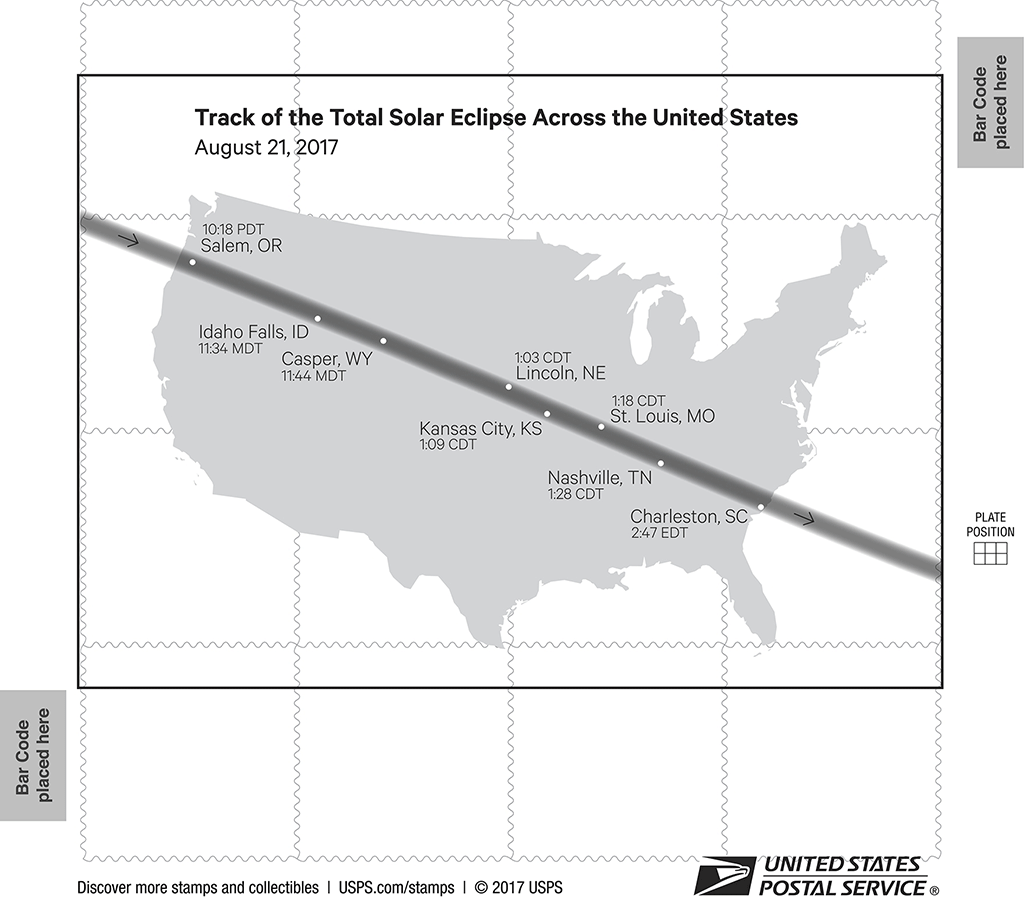 The back of the stamp pane provides a map of the August 21 eclipse path and times it may appear in some locations. Visit NASA’s website to view detailed maps of the eclipse’s path.
The back of the stamp pane provides a map of the August 21 eclipse path and times it may appear in some locations. Visit NASA’s website to view detailed maps of the eclipse’s path.
Thermochromic Ink
 The stamp image is a photograph taken by astrophysicist Fred Espenak, aka Mr. Eclipse, of Portal, AZ, that shows a total solar eclipse seen from Jalu, Libya, on March 29, 2006.
The stamp image is a photograph taken by astrophysicist Fred Espenak, aka Mr. Eclipse, of Portal, AZ, that shows a total solar eclipse seen from Jalu, Libya, on March 29, 2006.
In the first U.S. stamp application of thermochromic ink, the Total Solar Eclipse stamps will reveal a second image. Using the body heat of your thumb or fingers and rubbing the eclipse image will reveal an underlying image of the Moon (Espenak also took the photograph of the Full Moon). The image reverts back to the eclipse once it cools.
Thermochromic inks are vulnerable to UV light and should be kept out of direct sunlight as much as possible to preserve this special effect. To help ensure longevity, the Postal Service will be offering a special envelope to hold and protect the stamp pane for a nominal fee.
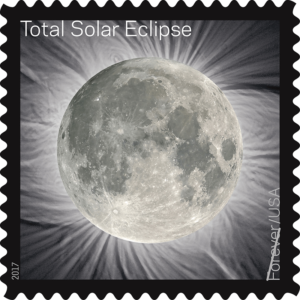 A total eclipse of the Sun occurs when the Moon completely blocks the visible solar disk from view, casting a shadow on Earth. The 70-mile-wide shadow path of the eclipse, known as the “path of totality,” will traverse the country diagonally, appearing first in Oregon (mid-morning local time) and exiting some 2,500 miles east and 90 minutes later off the coast of South Carolina (mid-afternoon local time).
A total eclipse of the Sun occurs when the Moon completely blocks the visible solar disk from view, casting a shadow on Earth. The 70-mile-wide shadow path of the eclipse, known as the “path of totality,” will traverse the country diagonally, appearing first in Oregon (mid-morning local time) and exiting some 2,500 miles east and 90 minutes later off the coast of South Carolina (mid-afternoon local time).
A total solar eclipse provides us with the only chance to see the Sun’s corona — its extended outer atmosphere — without specialized instruments. During the total phase of an eclipse the corona appears as a gossamer white halo around the black disk of the Moon, resembling the petals of a flower reaching out into space.
Art director Antonio Alcalá of Alexandria, VA, designed the stamp.
The Total Eclipse of the Sun stamp is being issued as a Forever stamp, which is always equal in value to the current First-Class Mail 1-ounce price.
The Postal Service receives no tax dollars for operating expenses and relies on the sale of postage, products and services to fund its operations.
Football Star Johan Cruijff (Netherlands 2017)
[press release]
Silver stamp for football icon Johan Cruijff
 PostNL honours Johan Cruijff by issuing a pure silver stamp. This special stamp comes exactly one year after the death of the Dutch football legend, and marks the fifth time that PostNL has issued a silver postage stamp.
PostNL honours Johan Cruijff by issuing a pure silver stamp. This special stamp comes exactly one year after the death of the Dutch football legend, and marks the fifth time that PostNL has issued a silver postage stamp.
Support the Johan Cruyff Foundation
PostNL marketing director Ludo Voorn reflects on the death of Johan Cruijff a year ago. “Everyone loved Johan Cruijff. Besides his widely respected great skill on the football field, he was always committed to bringing children together through sports. The Cruyff Foundation has built on this notion for years. We are proud to support their work by donating part of the proceeds from sales of this silver stamp.”
Niels Meijer, director of the Cruyff Foundation, feels it’s very special that PostNL is issuing such a valuable stamp in honour of the footballer. “Johan always filled a social role. We continue to do that. We will certainly be investing the proceeds from the stamp sales in a project such as Schoolyard 14. This will challenge students both during and after school to play and exercise together.”
Availability
PostNL has commissioned the Royal Dutch Mint to manufacture the postage stamp, which is made from pure silver. The stamp, in a deluxe storage box, is available for €25 via www.postnl.nl/cruijff. The stamp has a limited run of 1,400 copies. The postage stamp has the ‘Registered Mail’ designation, and may be therefore be used to send letters as registered mail. The stamps are valid for an unlimited period.
[Cruijff was a world-renowned and -beloved player and coached who died March 24, 2016, at the age of 68 from complications resulting from lung cancer. For more, see Wikipedia. —Virtual Stamp Club]



